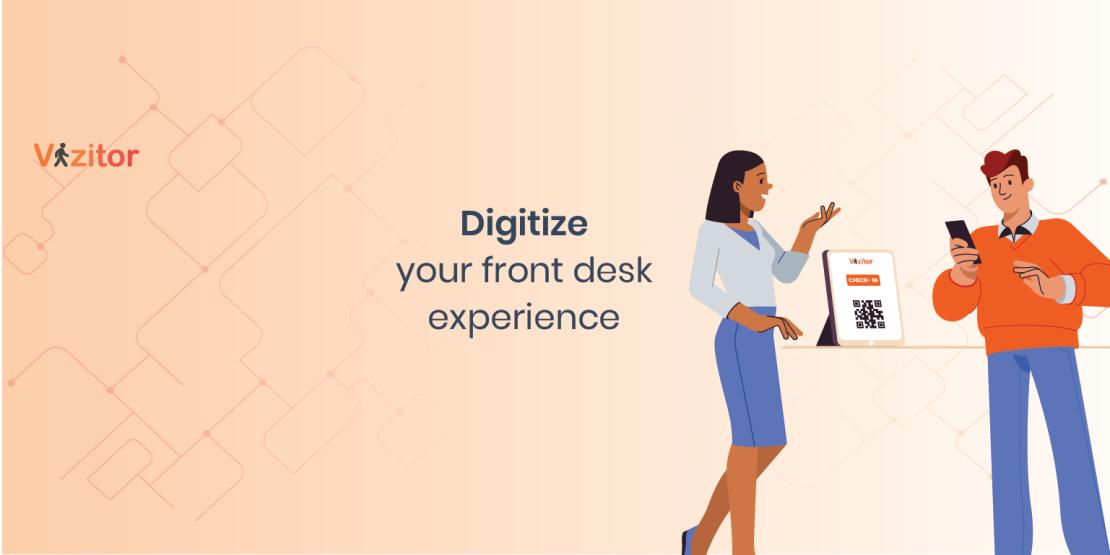Table of Content
Try Vizitor for Free!

Tue, May 21, 2024
Read in 8 minutes
Did you know that well-designed office spaces can boost employee productivity by up to 20%? This compelling statistic highlights the critical role that effective space planning plays in the modern workplace. As businesses strive to create environments that foster collaboration, innovation, and efficiency, the importance of strategic workplace space planning cannot be overstated.
Workplace space planning solutions involve more than just arranging desks and chairs; it’s about creating a dynamic and adaptable environment that meets the diverse needs of your workforce. From optimizing layout designs to ensuring adequate space utilization, effective space planning can significantly enhance the overall functionality and aesthetic appeal of your office.
In this blog, we will explore comprehensive solutions for workplace space planning. We’ll delve into the essential elements of space planning, discuss how to assess and optimize your current office layout and provide practical tips for implementing successful space planning strategies. Whether you’re looking to redesign your existing office or plan a new workspace from scratch, this guide will equip you with the knowledge and tools needed to create an efficient and productive work environment.
Understanding Workplace Space Planning
Workplace space planning is the process of organizing and designing office layouts to optimize the use of available space while meeting the functional needs of the organization. This involves strategically arranging furniture, equipment, and workstations to create an environment that supports employee productivity, collaboration, and well-being.
Common Challenges
Workplace space planning can be a complex situation, and several common challenges often arise:
Key Elements In Workplace Space Planning Solutions
1. Layout Design
• Workflow Optimization: Office space planning layout to support efficient workflows and minimize unnecessary movement.
• Zoning: Creating specific zones for different activities, such as collaboration areas, quiet workspaces, and social spaces.
• Accessibility: Ensuring that all areas of the office are easily accessible and compliant with accessibility standards.
3. Furniture Arrangement
• Ergonomics: Selecting furniture that supports good posture and reduces the risk of injuries.
• Modularity: Choosing modular furniture that can be easily reconfigured to adapt to changing needs.
• Aesthetic Appeal: Incorporating furniture that complements the office design and creates a cohesive look.
4. Space Utilization
• Maximizing Efficiency: Making the most of available space by using multi-functional furniture and smart storage solutions.
• Avoiding Wasted Space: Identifying and repurposing underutilized areas to serve new functions.
• Scalability: Planning for future growth and ensuring that the space can accommodate an increasing number of employees.
5. Flexibility
• Adaptable Workspaces: Designing spaces that can be easily reconfigured to meet the changing needs of the business.
• Multi-Functional Areas: Creating areas that can serve multiple purposes, such as a meeting room that doubles as a quiet workspace.
• Future-Proofing: Incorporating flexible design elements that can evolve with the organization, such as movable walls and adjustable lighting.
Assessing Current Space Utilization
This process lays the foundation for effective space planning, enabling organizations to create environments that enhance productivity, foster collaboration, and support employee well-being.
1. Conducting Space Audits
Conducting space audits is the first step in assessing current space utilization. This process involves a detailed analysis of how space is currently used and identifying areas for improvement. Here’s how to conduct an effective space audit:
2. Analyzing Workforce Needs
Understanding the needs of your workforce is crucial for creating an efficient and productive workspace. Here’s how to analyze workforce needs effectively:
Developing an Effective Space Plan
By setting clear goals and objectives, adhering to effective design principles, and incorporating flexibility, businesses can develop a space plan that not only meets their current needs but also supports long-term growth and success.
Setting Goals and Objectives
Developing an effective space plan begins with setting clear goals and objectives. These goals should align with the overall business strategy and address the specific needs of the organization. Consider the following steps:
Objectives
• Determine what you aim to achieve with your space plan. Objectives might include improving productivity, enhancing employee well-being, fostering collaboration, or accommodating future growth.
• Identify and prioritize the most critical needs of your workforce and organization. This could involve creating more collaborative spaces, ensuring quiet areas for focused work, or integrating advanced technology.
• Ensure that your space planning goals align with broader business objectives. For example, if your company is focused on innovation, your space plan should support creative thinking and collaboration.
• Establish clear, measurable targets to track the success of your space planning efforts. This could include metrics such as improved employee satisfaction, increased space utilization, or reduced operational costs.
Design Principles
• Design spaces that serve their intended purposes effectively. This involves considering the specific tasks and activities that will take place in each area and ensuring that the design supports these functions.
• Create a visually appealing environment that reflects the company’s brand and culture. A well-designed space can boost employee morale and make a positive impression on clients and visitors.
• Divide the office into zones based on different activities. Common zones include collaborative areas, quiet workspaces, social spaces, and meeting rooms. Zoning helps to organize the space and improve workflow.
• Incorporate natural light and ensure good air quality to create a healthy and pleasant working environment. This can enhance employee well-being and productivity.
Incorporating Flexibility
• Use modular furniture that can be easily reconfigured to accommodate different activities and team sizes. This allows for quick adjustments to the layout as needed.
• Design areas that can serve multiple purposes, such as a meeting room that doubles as a quiet workspace or a lounge area that can be converted into a collaboration zone.
• Incorporate movable walls and partitions to create adaptable spaces. These elements can be repositioned to change the layout and function of an area without major renovations.
• Plan for future growth and technological advancements by incorporating scalable and upgradable elements into the design. This ensures that the workspace can evolve with the organization.
Implementing Space Planning Solutions
By focusing on effective project management, leveraging technology and tools, and incorporating sustainable design principles, organizations can implement space planning solutions that are efficient, adaptive, and environmentally responsible.
1. Project Management
• This involves coordinating various aspects of the project, from initial planning to final execution, to ensure that the space is designed and set up efficiently.
• Clearly outline the scope of the project, including the specific areas to be redesigned or reconfigured. Establish a realistic budget that covers all aspects of the project, from design and materials to labor and contingency funds.
• Develop a detailed timeline that includes all phases of the project, from initial planning and design to implementation and final review. Ensure that deadlines are realistic and allow for any potential delays.
• Build a project team that includes key stakeholders, such as interior designers, architects, contractors, and IT specialists. Assign specific roles and responsibilities to each team member to ensure accountability.
2. Technology and Tools
• Tools like CAD (Computer-Aided Design) and BIM (Building Information Modeling) software allow for precise planning and visualization of the space. These tools enable designers to create detailed floor plans and 3D models, facilitating better decision-making.
• These devices help track how different areas of the office are used in real-time. Data from occupancy sensors can inform adjustments to the layout to optimize space utilization.
• Project management and collaboration platforms like Asana, Trello, or Microsoft Teams can streamline communication and task management among project team members.
• Virtual Reality (VR) and Augmented Reality (AR) technologies can provide immersive experiences, allowing stakeholders to virtually walk through the redesigned space and make necessary adjustments before implementation.
3. Measuring Success and Making Adjustments
• Identify specific metrics to measure the success of the space plan. These might include employee productivity levels, space utilization rates, employee satisfaction scores, and operational efficiency.
• Conduct regular inspections of the workspace to ensure that the layout and design are functioning as intended. Look for any signs of wear and tear or areas that are not being used as planned.
• Utilize technology, such as occupancy sensors and space management software, to collect real-time data on space usage. Analyze this data to identify patterns and areas for improvement.
• Schedule periodic reviews to assess the effectiveness of the space plan. Compare the current performance with the baseline data collected before implementation to measure improvements.
4. Gathering Feedback
• surveys and distribute questionnaires to gather employee opinions on the new workspace design. Include questions about comfort, productivity, collaboration, and overall satisfaction.
• Organize focus groups with representatives from different departments to discuss their experiences with the new space plan. This allows for in-depth insights and more nuanced feedback.
• Provide anonymous suggestion boxes (both physical and digital) where employees can share their thoughts and ideas for further improvements.
• Conduct one-on-one meetings with team leaders and managers to gather specific feedback from their teams. This can help identify department-specific issues and solutions.
Vizitor - Let The Expert Handle It!
Doesn’t it all seem a little too overwhelming? Managing, planning, and implementing can indeed require a lot of effort and manpower. But what if all of this could be streamlined and done seamlessly, even single-handedly?
That’s where Vizitor comes in!
Vizitor offers a comprehensive Workplace Management System designed to simplify and enhance various aspects of your organization. From streamlined processes to efficient delivery, attendance management, and optimized space utilization, Vizitor is your one-stop solution for upgrading your workplace experience.
Imagine having a system that automates visitor check-ins, tracks employee attendance effortlessly, manages workspace bookings efficiently, and ensures c










